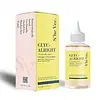What's inside
What's inside
 Key Ingredients
Key Ingredients

 Benefits
Benefits

 Concerns
Concerns

 Ingredients Side-by-side
Ingredients Side-by-side

Water
Skin ConditioningGlycolic Acid
BufferingGlycerin
HumectantPropanediol
SolventC12-13 Pareth-9
EmulsifyingNiacinamide
SmoothingRosa Damascena Flower Water
MaskingPhenethyl Alcohol
MaskingInulin
Skin ConditioningAloe Barbadensis Leaf Extract
EmollientPanthenol
Skin ConditioningCaprylyl Glycol
EmollientHydroxyethylcellulose
Emulsion StabilisingPotassium Sorbate
PreservativeSodium Hyaluronate
HumectantPanax Ginseng Root Extract
EmollientTasmannia Lanceolata Fruit/Leaf Extract
AntioxidantSodium PCA
HumectantSodium Lactate
BufferingFructose
HumectantArginine
MaskingAspartic Acid
MaskingHamamelis Virginiana Extract
AntiseborrhoeicPCA
HumectantPentylene Glycol
Skin ConditioningGlycine
BufferingAlanine
MaskingSerine
MaskingValine
MaskingProline
Skin ConditioningThreonine
Isoleucine
Skin ConditioningHistidine
HumectantPhenylalanine
MaskingAscorbyl Palmitate
AntioxidantWater, Glycolic Acid, Glycerin, Propanediol, C12-13 Pareth-9, Niacinamide, Rosa Damascena Flower Water, Phenethyl Alcohol, Inulin, Aloe Barbadensis Leaf Extract, Panthenol, Caprylyl Glycol, Hydroxyethylcellulose, Potassium Sorbate, Sodium Hyaluronate, Panax Ginseng Root Extract, Tasmannia Lanceolata Fruit/Leaf Extract, Sodium PCA, Sodium Lactate, Fructose, Arginine, Aspartic Acid, Hamamelis Virginiana Extract, PCA, Pentylene Glycol, Glycine, Alanine, Serine, Valine, Proline, Threonine, Isoleucine, Histidine, Phenylalanine, Ascorbyl Palmitate
Ingredients Explained
These ingredients are found in both products.
Ingredients higher up in an ingredient list are typically present in a larger amount.
Glycolic Acid is arguably the most famous alpha hydroxy acid (AHA) with tons of research backing its benefits.
It is found naturally in sugar cane but the form used in skincare is usually synthetic for purity and stability.
Glycolic acid removes the top layer of dead skin cells to allow newer and fresher ones to emerge.
AHAs work by breaking down the structural “glue” that holds old skin cells in place. When that buildup is gone, your skin can renew itself more efficiently.
Research also shows glycolic acid stimulates collagen production, helping to firm and thicken the skin over time. This is one of its biggest advantages over other AHAs.
Overall, glycolic acid helps with:
Fun fact: Glycolic acid boosts skin hydration by helping it produce molecules that increase hyaluronic acid naturally.
To work best, glycolic acid products should have a pH between 3-4 (that’s where exfoliation is most effective but still gentle on skin).
The pH and concentration of a product are key to its effectiveness:
It is normal to feel a slight stinging sensation when using glycolic acid. This usually fades as your skin adjusts.
Because glycolic acid has the smallest molecular size in the AHA family, it can penetrate deeper, which enhances its effectiveness but also makes it more likely to irritate sensitive skin.
If your skin is very sensitive or prone to rosacea, glycolic acid may be too strong; in that case, try milder options like lactic acid or a PHA instead.
Recent studies suggest glycolic acid might even help protect against UV damage. But don’t skip sunscreen! Freshly exfoliated skin is more sensitive to the sun.
Glycolic acid is a skincare superstar. It smooths, brightens, hydrates, and firms the skin. Unless you’re highly sensitive, it’s well worth adding to your routine.
Read more about some other popular AHA's here:
Learn more about Glycolic Acid